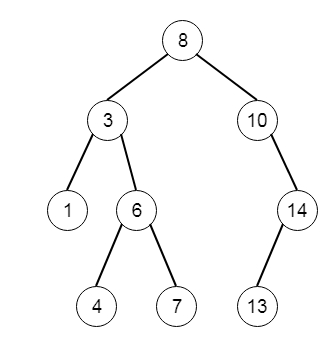
 Data Structure
Data Structure Networking
Networking RDBMS
RDBMS Operating System
Operating System Java
Java MS Excel
MS Excel iOS
iOS HTML
HTML CSS
CSS Android
Android Python
Python C Programming
C Programming C++
C++ C#
C# MongoDB
MongoDB MySQL
MySQL Javascript
Javascript PHP
PHP
- Selected Reading
- UPSC IAS Exams Notes
- Developer's Best Practices
- Questions and Answers
- Effective Resume Writing
- HR Interview Questions
- Computer Glossary
- Who is Who
Maximum Difference Between Node and Ancestor in C++
Suppose we have the root of a binary tree, we have to find the maximum value V for which there exists different nodes A and B where V = |value of A – value of B| and A is an ancestor of B. So if the tree is like −

Then the output will be 7. The ancestor node differences are like [(8 - 3), (7 - 3), (8 - 1), (10-13)], among them the (8 - 1) = 7 is the maximum.
To solve this, we will follow these steps −
initially define ans 0
define one method called solve(), this will take the tree node, currMin and currMax. This will act as follows −
if node is null, then return
ans := maximum of ans, |value of node - currMin|, |value of node - currMax|
solve(left of node, minimum of node value and currMin, maximum of node value and currMax)
solve(right of node, minimum of node value and currMin, maximum of node value and currMax)
In the main section, call solve(root, value of root, value of root), and return ans
Let us see the following implementation to get better understanding −
Example
#include <bits/stdc++.h>
using namespace std;
class TreeNode{
public:
int val;
TreeNode *left, *right;
TreeNode(int data){
val = data;
left = NULL;
right = NULL;
}
};
void insert(TreeNode **root, int val){
queue<TreeNode*> q;
q.push(*root);
while(q.size()){
TreeNode *temp = q.front();
q.pop();
if(!temp->left){
if(val != NULL)
temp->left = new TreeNode(val);
else
temp->left = new TreeNode(0);
return;
}else{
q.push(temp->left);
}
if(!temp->right){
if(val != NULL)
temp->right = new TreeNode(val);
else
temp->right = new TreeNode(0);
return;
}else{
q.push(temp->right);
}
}
}
TreeNode *make_tree(vector<int> v){
TreeNode *root = new TreeNode(v[0]);
for(int i = 1; i<v.size(); i++){
insert(&root, v[i]);
}
return root;
}
class Solution {
public:
int ans;
void solve(TreeNode* node, int currMin, int currMax){
if (!node || node->val == 0) return;
ans = max({ans, abs(node->val - currMin), abs(node->val -
currMax)});
solve(node->left, min(node->val, currMin), max(node->val,
currMax));
solve(node->right, min(node->val, currMin), max(node->val,
currMax));
}
int maxAncestorDiff(TreeNode* root) {
ans = 0;
solve(root, root->val, root->val);
return ans;
}
};
main(){
vector<int> v = {8,3,10,1,6,NULL,14,NULL,NULL,4,7,13};
TreeNode *root = make_tree(v);
Solution ob;
cout << (ob.maxAncestorDiff(root));
}
Input
[8,3,10,1,6,null,14,null,null,4,7,13]
Output
7

